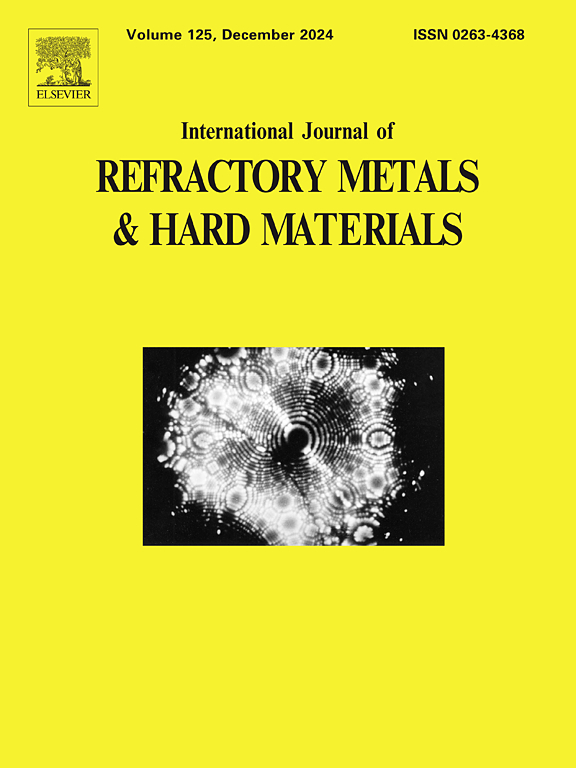Effect of W content on microstructure and corrosion-wear properties of WNi coatings by laser cladding
IF 4.2
2区 材料科学
Q2 MATERIALS SCIENCE, MULTIDISCIPLINARY
International Journal of Refractory Metals & Hard Materials
Pub Date : 2024-10-19
DOI:10.1016/j.ijrmhm.2024.106925
引用次数: 0
Abstract
xW-Ni (x = 60, 70, 80, 90 wt%) coatings were prepared by laser cladding on the surface of X80 steel substrate to explore the effects of different W contents on the microstructure, corrosion resistance, microhardness and corrosion-wear properties of the W![]() Ni coatings. The results revealed that the microstructure of the various W
Ni coatings. The results revealed that the microstructure of the various W![]() Ni coatings composed of W and γ (Ni, Fe) phases. The increase in W content resulted in more W atoms being dissolved in the γ (Ni, Fe) phase, enhancing the solid solution strengthening effect, which increased the average microhardness of the coating. Moreover, the addition of W provided diffusion channels for metal ions to migrate to the surface of the coating for passivation film formation, which improved the corrosion resistance of the coating. However, the addition of excessive amounts of W caused the coating density to decrease and accelerated galvanic corrosion. The 80 W-Ni coating among the studied coatings exhibited excellent corrosive-wear resistance due to its high hardness and good corrosion resistance. This coating corrosive-wear mechanism was the combination of abrasive wear and corrosion.
Ni coatings composed of W and γ (Ni, Fe) phases. The increase in W content resulted in more W atoms being dissolved in the γ (Ni, Fe) phase, enhancing the solid solution strengthening effect, which increased the average microhardness of the coating. Moreover, the addition of W provided diffusion channels for metal ions to migrate to the surface of the coating for passivation film formation, which improved the corrosion resistance of the coating. However, the addition of excessive amounts of W caused the coating density to decrease and accelerated galvanic corrosion. The 80 W-Ni coating among the studied coatings exhibited excellent corrosive-wear resistance due to its high hardness and good corrosion resistance. This coating corrosive-wear mechanism was the combination of abrasive wear and corrosion.
W 含量对激光熔覆 WNi 涂层微观结构和腐蚀磨损性能的影响
采用激光熔覆方法在 X80 钢基体表面制备了 xW-Ni(x = 60、70、80、90 wt%)涂层,以探讨不同 W 含量对 WNi 涂层的微观结构、耐腐蚀性、显微硬度和腐蚀磨损性能的影响。结果表明,不同 WNi 涂层的微观结构由 W 相和γ(Ni、Fe)相组成。W 含量的增加使更多的 W 原子溶解在 γ(Ni、Fe)相中,增强了固溶强化效应,从而提高了涂层的平均显微硬度。此外,W 的添加为金属离子迁移到涂层表面形成钝化膜提供了扩散通道,从而提高了涂层的耐腐蚀性。然而,过量 W 的添加会导致涂层致密性降低,加速电化学腐蚀。在所研究的涂层中,80 W-Ni 涂层因其高硬度和良好的耐腐蚀性而表现出优异的耐腐蚀磨损性。该涂层的腐蚀磨损机理是磨料磨损和腐蚀的结合。
本文章由计算机程序翻译,如有差异,请以英文原文为准。
求助全文
约1分钟内获得全文
求助全文
来源期刊
CiteScore
7.00
自引率
13.90%
发文量
236
审稿时长
35 days
期刊介绍:
The International Journal of Refractory Metals and Hard Materials (IJRMHM) publishes original research articles concerned with all aspects of refractory metals and hard materials. Refractory metals are defined as metals with melting points higher than 1800 °C. These are tungsten, molybdenum, chromium, tantalum, niobium, hafnium, and rhenium, as well as many compounds and alloys based thereupon. Hard materials that are included in the scope of this journal are defined as materials with hardness values higher than 1000 kg/mm2, primarily intended for applications as manufacturing tools or wear resistant components in mechanical systems. Thus they encompass carbides, nitrides and borides of metals, and related compounds. A special focus of this journal is put on the family of hardmetals, which is also known as cemented tungsten carbide, and cermets which are based on titanium carbide and carbonitrides with or without a metal binder. Ceramics and superhard materials including diamond and cubic boron nitride may also be accepted provided the subject material is presented as hard materials as defined above.

 求助内容:
求助内容: 应助结果提醒方式:
应助结果提醒方式:


